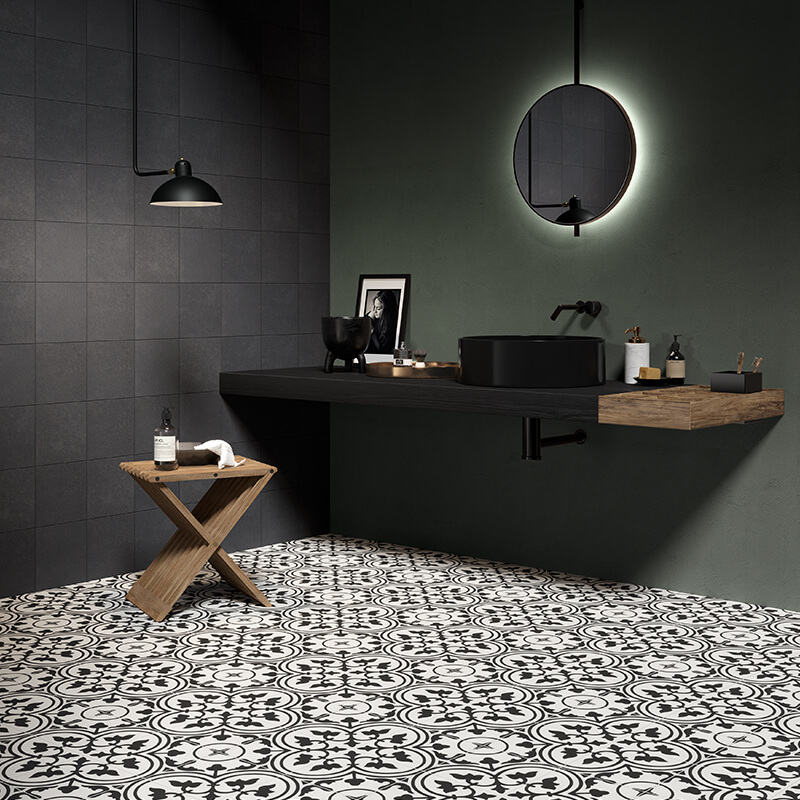Ceramic tile is one of the most durable, low-maintenance, and stylish surface materials you can choose for your home or business. At D’Amico Ceramic, we know that with just a little regular care, your tile can maintain its original beauty and function for decades.
While ceramic tile requires minimal upkeep, the grout between the tiles deserves a bit of extra attention. In this guide, we’ll explain why ceramic tile is so easy to maintain, how to care for it, and the simple steps you can take to protect your investment.
Why Ceramic Tile Is Considered Low-Maintenance
Ceramic tile is built to last — it’s one of the few flooring materials that can handle years of foot traffic, spills, and everyday wear without losing its luster. Here’s why it stands out:
1. Resistant to Moisture and Stains
Glazed ceramic tile is non-porous, meaning it naturally repels water, stains, and most household spills. This makes it an excellent choice for moisture-prone areas like bathrooms, kitchens, and entryways.
2. Easy to Clean
Daily cleaning is as simple as sweeping or wiping with water. There’s no need for harsh chemicals or expensive cleaning systems — just gentle, consistent maintenance.
3. Durable and Long-Lasting
Ceramic tile resists scratches, dents, and fading. Whether it’s installed in a high-traffic hallway or a busy family kitchen, it maintains its look for decades with little effort.
4. Hygienic and Allergen-Free
The smooth, non-porous surface prevents the buildup of dust, allergens, bacteria, and mold. A quick wipe keeps your home feeling fresh and healthy year-round.
Grout: The Only Area That Needs Extra Care
The grout between tiles is what keeps your surface sealed and stable — but it’s also the most vulnerable to stains and moisture.
Seal Your Grout
After installation, apply a grout sealer to protect against discoloration and absorption. Resealing once a year (or as needed) is recommended to keep the grout looking clean and new.
Clean Grout Gently
Use a pH-neutral cleaner or a tile-safe cleaning solution. Avoid harsh chemicals like bleach, vinegar, or ammonia — these can weaken the grout and dull the tile finish.
A soft sponge or microfiber cloth works best for everyday cleaning.
Handle Minor Repairs Promptly
Over time, natural movement in your home may cause slight grout cracking near walls or cabinets. These are easy to touch up — simply apply matching grout or a grout colorant for a seamless finish.
Simple Daily and Weekly Tile Maintenance Tips
A little consistency goes a long way when it comes to keeping ceramic tile pristine.
Sweep or Vacuum Regularly
Dirt and grit can act like sandpaper, dulling the surface over time. Sweep daily or vacuum using a non-beater bar setting.
Mop Sparingly with Clean Water
Avoid soaking your tile — while the tile itself is waterproof, grout and underlayment are not. Use minimal water and rinse thoroughly to remove residue.
Clean Spills Immediately
Even though glazed tile resists stains, it’s best to wipe up food, grease, or liquids right away to prevent grout discoloration.
Protect from Heavy Furniture
Use felt pads under table and chair legs to prevent chips and scratches when moving furniture.
Bathroom and Kitchen Tile Care
These areas experience higher humidity and more frequent messes — but they’re still easy to maintain.
Showers and Tubs
Use a squeegee after each shower to remove water from tiles and grout lines. This simple habit prevents mildew and water stains. Avoid leaving metal containers on tile surfaces, as they can rust and leave permanent marks.
Countertops and Backsplashes
Wipe surfaces daily with a mild dishwater solution and a soft cloth. Use a tile-safe cleaner weekly to remove grease buildup, then rinse with clean water to maintain a streak-free shine.
Extra Tips for Long-Term Success
Inspect Caulk and Expansion Joints
Where tile meets tubs, countertops, or walls, check caulking periodically. Reapply when needed to prevent moisture seepage.
💡 Pro Tip: Fill your bathtub with water before re-caulking to prevent future cracking as the tub shifts.
Store Leftover Tiles and Grout
Always keep extra tiles and sealed grout from your installation. Each batch can vary slightly in color, so having spares ensures perfect replacements if needed later.
Maintain a Simple Cleaning Schedule
- Weekly: Sweep and spot clean.
- Monthly: Deep clean grout lines.
- Annually: Reseal grout if using a cement-based type.
FAQs About Ceramic Tile Maintenance
Is ceramic tile high-maintenance?
No — ceramic tile is one of the most low-maintenance flooring options available. It only requires regular sweeping, light mopping, and occasional grout care.
How often should grout be sealed?
Typically once per year, depending on traffic and product quality. High-traffic or wet areas may require more frequent sealing.
What’s the best cleaner for ceramic tile floors?
A pH-neutral tile cleaner or a mix of warm water and mild dish soap is ideal. Avoid acids, bleach, or ammonia-based products.
How can I prevent grout from staining?
Seal it after installation and reseal regularly. Clean spills right away and use mats near entryways to reduce tracked-in dirt.
Can I use steam cleaners on ceramic tile?
Yes, but check your manufacturer’s recommendations first. Steam cleaning is effective for grout lines but should not be used excessively.
Final Thoughts: Beautiful Tile, Minimal Effort
Ceramic tile truly offers the best of both worlds — timeless beauty and lasting durability with very little upkeep. By focusing on gentle cleaning habits and regular grout maintenance, you’ll keep your tile floors, walls, and surfaces looking brand new for decades.
At D’Amico Ceramic, we specialize in premium ceramic tile installation and expert maintenance guidance to help your investment last a lifetime.
💬 Ready to upgrade your home or business with low-maintenance ceramic tile?
Contact D’Amico Ceramic today for a free consultation or visit our showroom to explore our full range of stunning ceramic tile options.


